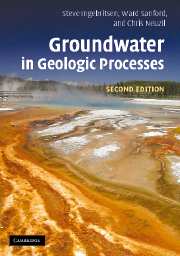Book contents
- Frontmatter
- Contents
- Preface
- Acknowledgements
- List of symbols
- 1 Groundwater flow
- 2 Hydromechanical coupling
- 3 Solute transport
- 4 Heat transport
- 5 Regional-scale flow and transport
- 6 Ore deposits
- 7 Hydrocarbons
- 8 Geothermal processes
- 9 Earthquakes
- 10 Evaporites
- 11 Compaction and diagenesis
- 12 Metamorphism
- 13 Subsea hydrogeology
- References
- Index
5 - Regional-scale flow and transport
Published online by Cambridge University Press: 12 January 2023
- Frontmatter
- Contents
- Preface
- Acknowledgements
- List of symbols
- 1 Groundwater flow
- 2 Hydromechanical coupling
- 3 Solute transport
- 4 Heat transport
- 5 Regional-scale flow and transport
- 6 Ore deposits
- 7 Hydrocarbons
- 8 Geothermal processes
- 9 Earthquakes
- 10 Evaporites
- 11 Compaction and diagenesis
- 12 Metamorphism
- 13 Subsea hydrogeology
- References
- Index
Summary
This chapter represents a transition between the basic theory of previous chapters and the particular applications of Chapters 6 to 13. Here we apply the theory of groundwater flow, hydromechanics, and transport in a fairly generic sense, whereas in later chapters we focus on applications of these ideas to more particular geologic processes and environments. Specific topics to be addressed in this chapter include regional groundwater flow (Section 5.1), anomalous fluid pressures within regional flow systems (Section 5.2), and phenomena related to regional-scale solute (Section 5.3) and heat transfer (Section 5.4). Thus the four sections of this chapter parallel, and build on, the theoretical framework introduced sequentially in Chapters 1–4 (groundwater flow, hydromechanics, solute transport, heat transport). The theoretical development here is limited, and is intended simply to facilitate first-order computations.
In real systems the processes of groundwater flow and mechanical deformation, solute transport, and heat transport are fully coupled (e.g., Person and others, 1996), and various mechanisms combine to drive groundwater flow in particular localities. For example, in the Gulf Coast basin of the south-central United States and eastern Mexico (Section 5.2.4) there is shallow topographically driven flow, thermohaline convection near salt domes (Section 10.3.1), and compaction-driven flow. However, in this chapter, as in Chapters 1 to 4, we will generally simplify the analyses by treating groundwater flow and deformation, solute transport, and heat transport as if they were independent processes. In later chapters we will introduce a few of the intercouplings and other complexities associated with particular geologic processes.
Regional groundwater flow
A useful starting point for discussion of regional groundwater flow is to consider the driving forces for fluid flow and the approximate magnitudes of flow associated with these driving forces. Two energy sources ultimately drive fluid circulation in the crust: solar radiation and the Earth's internal heat (Cathles, 1990). Solar radiation evaporates roughly 420 000 km3/yr of water from the world oceans. About 110 000 km3/yr falls as precipitation on the continents, of which roughly two thirds is evaporated or transpired. Because direct runoff is minimal – most water in streams and rivers has passed through the subsurface – this leaves approximately 40 000 km3/yr to circulate through the subsurface.
- Type
- Chapter
- Information
- Groundwater in Geologic Processes , pp. 157 - 192Publisher: Cambridge University PressPrint publication year: 2006



